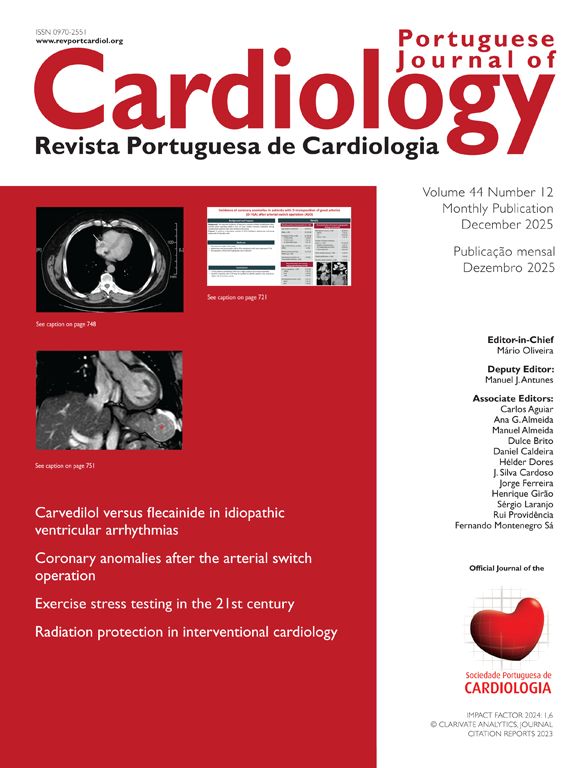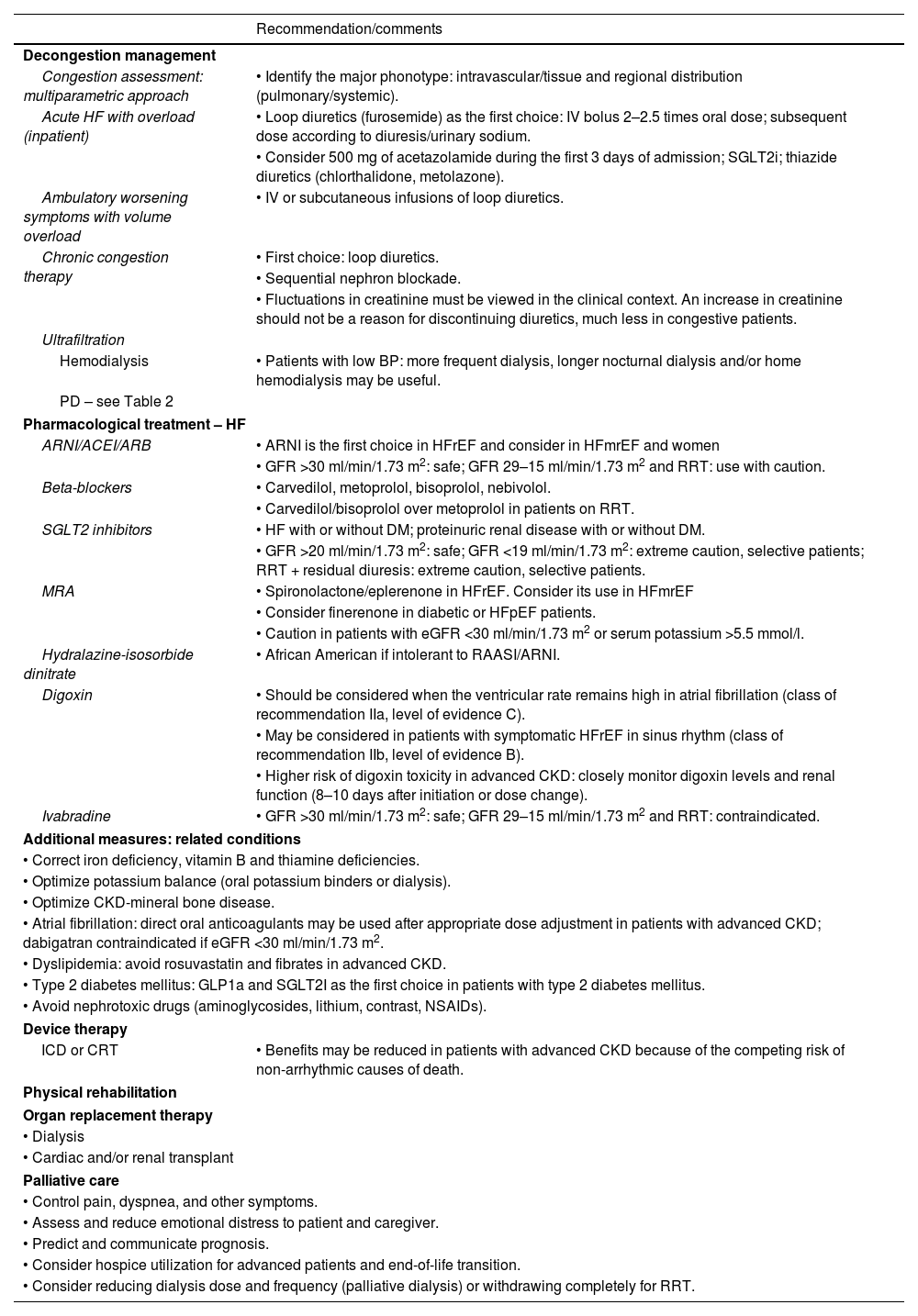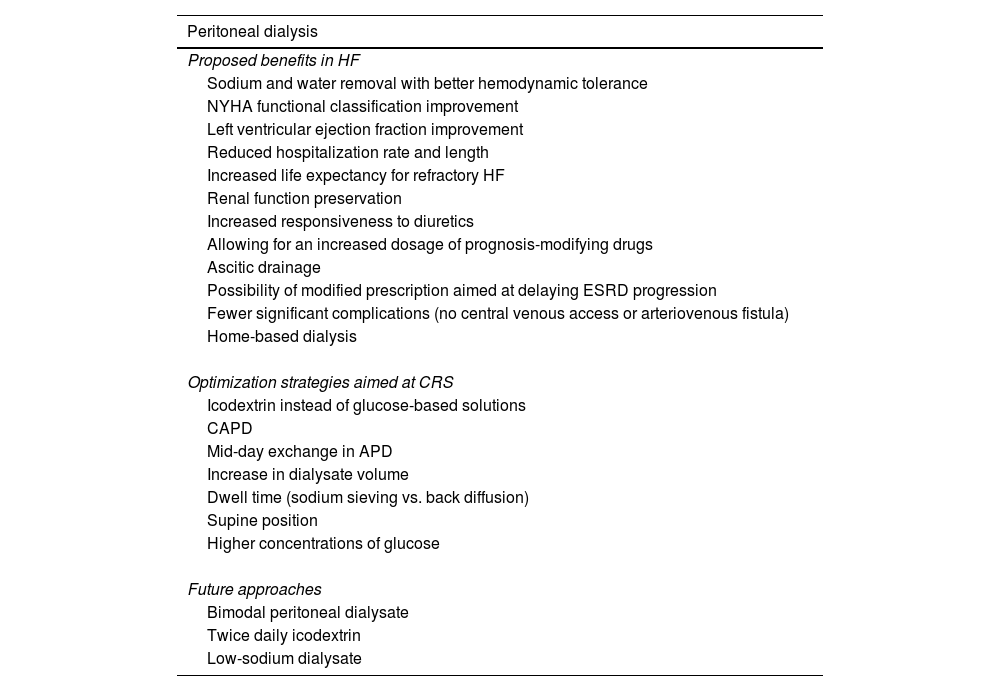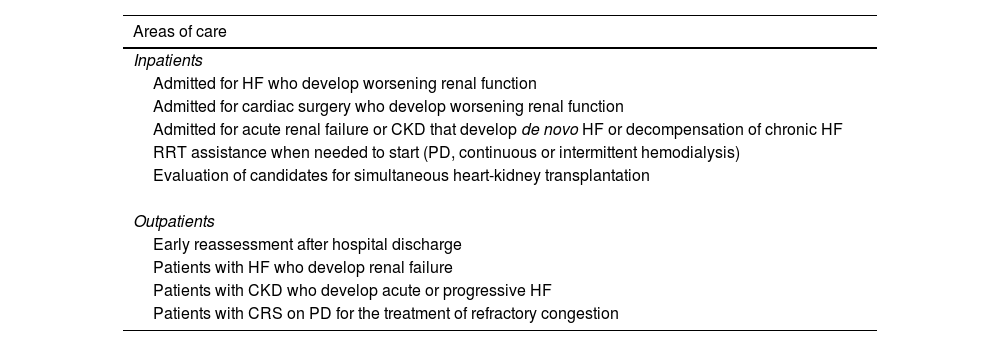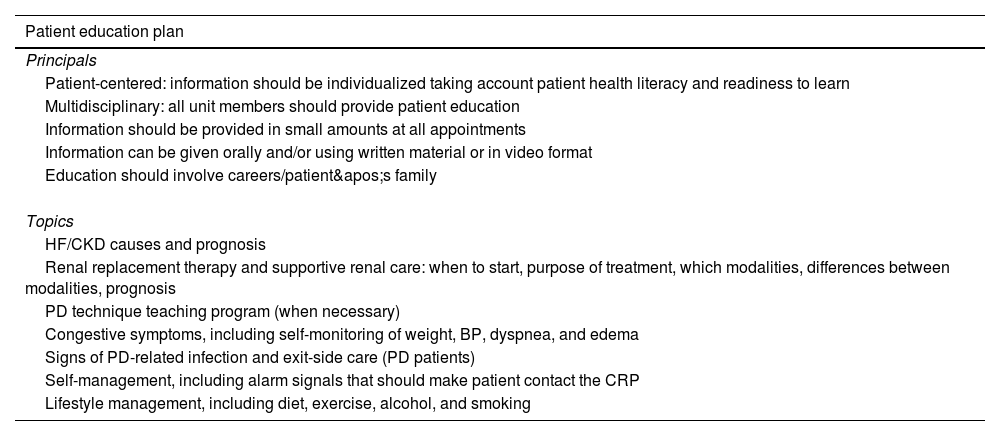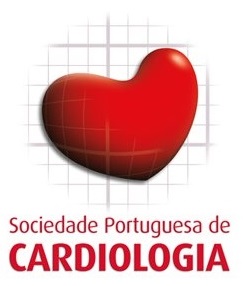The cardiorenal program (CRP), implemented within a specialized heart failure and kidney disease clinic, encompasses a multidisciplinary approach to the management of patients with heart failure and kidney disease. It focuses on optimizing therapy and improving patient outcomes. The CRP includes a range of services, including clinical evaluation, diagnostic testing, medical treatment, and patient education. The program provides comprehensive care for patients with cardiorenal syndrome, and includes a variety of healthcare professionals, such as cardiologists, nephrologists, pharmacists, and nurses, working together to provide the best possible care. The program also incorporates specific performance indicators to continuously evaluate and improve patient outcomes. The CRP's integrated multidisciplinary care and patient-centered approach is promising for the management of patients with cardiorenal syndrome.
O Programa Cardiorrenal, inserido numa clínica especializada em insuficiência cardíaca, baseia-se numa abordagem multidisciplinar para o seguimento de doentes com insuficiência cardíaca e doença renal crónica, com foco na otimização terapêutica e na melhoria dos resultados dos doentes. O Programa Cardiorrenal inclui avaliação clínica, exames complementares de diagnóstico, tratamento médico e educação do doente por uma equipa multidisciplinar composta por diversos profissionais de saúde, como cardiologistas, nefrologistas, farmacêuticos e enfermeiros, trabalhando juntos para fornecer o melhor atendimento possível. O programa também incorpora indicadores de desempenho específicos para avaliar e melhorar continuamente os resultados dos doentes. Com foco no cuidado multidisciplinar integrado e na abordagem centrada no doente, o Programa Cardiorrenal oferece uma abordagem promissora para o manejo de doentes com síndrome cardiorrenal.
Cardiorenal syndrome (CRS) refers to a range of conditions that affect both the heart and the kidneys, in which an acute or chronic dysfunction in one organ triggers metabolic and immunological processes that ultimately lead to dysfunction in the other organ as well as other organ systems.1,2
The incidence of heart failure (HF) and chronic kidney disease (CKD) is high in our clinical practice,3–5 and has a significant impact on our patients in terms of symptom burden, frequent hospitalizations, and increased risk of mortality.1–3 The estimated incidence of de novo HF in CKD is 17–21% and varies according to factors such as the degree of CKD and the type of kidney replacement therapy.6 A large meta-analysis with heart failure with reduced ejection fraction (HFrEF) and heart failure with preserved ejection fraction found that 55% of both groups had CKD G3a or higher, with a stepwise increase in mortality risk according to the stage of CKD.7 Both diseases contribute to increased risk of hospitalization, rehospitalization and death in a bidirectional manner.8,9
Managing CRS is challenging because many of the major randomized clinical trials in HF do not include patients with advanced CKD. Advanced CKD is defined as a severe reduction in estimated glomerular filtration rate (eGFR <30 ml/min/1.73 m2),10 making it challenging to determine effective treatments for this specific patient population. As a result, there is a lack of evidence-based therapies for patients with advanced CKD and CRS.2,10,11 Thus, CRS treatment strategies have been largely empirical and goal-directed to improve the function of one organ, often at the expense of the other. Interpreting changes in renal function can also be challenging when it comes to achieving proper decongestion in patients with decompensated HF, as well as optimizing HF prognosis-modifying drugs. The difficulty in accurately interpreting fluctuations in renal function poses an additional hurdle in both cases.5
In recent years, there has been a greater understanding of the connection between these two conditions, particularly in recognizing that CKD is a significant cardiovascular risk factor. As a result, new clinical trials have been conducted involving patients with CKD and CRS12–14 leading to the development of consensus documents on the detection, prevention, diagnosis, and management of these patients.6,10,14–17
Congestion is one of the key elements of the pathophysiology of HF and is associated with poor prognosis.18,19 In cases of refractory congestive HF, home dialysis such as peritoneal dialysis (PD) has been used as a home-based therapy to improve volume status20–26 and can be an add-on to medical therapy.15,23,27
Peritoneal dialysis offers a way to remove sodium and water according to individualized needs, and it also allows patients to benefit from guideline-directed medical therapy more fully for HF that may otherwise be difficult to use.20,23,28
The current model for managing CRS involves each specialty providing periodic care to patients, with cardiologists and internists treating mainly patients with CRS types 1 and 2, and nephrologists treating types 3 and 4. While each specialist has expertise and advanced skills in each individual condition, none are fully equipped to offer a comprehensive approach that optimally addresses the complex interrelationship between the heart and the kidneys. Therefore, the adoption of conflicting therapeutic strategies can occur, resulting from a limited perspective on this complex interplay between the heart and the kidneys. In addition, the follow-up of patients at multiple appointments can increase the disease burden, which can lead to worse adherence to hospital visits and medical therapy. Also, HF and CKD often coexists with relevant comorbidities that worsen prognosis and may complicate management.4,10,18,29–31
These ideas support the creation of an integrated and multidisciplinary approach to provide holistic, coordinated, and specialized care.4,5,10,15,30,31 From a practical standpoint, this approach would enable patients to receive appropriate studies, accurate diagnosis, education, evidence-based therapies, and suitable follow-up on all aspects of CRS treatment.30,32,33
Providing integrated care to chronic patients within each health area can be challenging due to organizational complexity.4,5 Therefore, the cardiorenal program (CRP) aims to provide specialized, comprehensive care to patients with kidney and cardiovascular diseases, with a focus on efficacy and safety. The purpose of this paper is to outline the key features of CRP, ensuring that the actions and results obtained through the program meet high standards of care.
Definition and aimsThe CRP model of care involves an interdisciplinary and collaborative program between nephrology and cardiology/internal medicine (Figure 1). The primary objective is to enhance the medical care provided to patients with CRS, with a focus on improving their quality of life, reducing morbidity and mortality, adopting a standardized clinical approach, optimizing treatment options, and improving their overall prognosis4,5,10,14,15:
- •
To promote an integrated approach to the CRS patient, assuring healthcare equity for all patients.
- •
To reduce treatment variability by implementing clinical protocols based on updated best practice and current guidelines.
- •
To optimize pharmacological treatment by adjusting drug dosage in each stage of CRS, and non-pharmacological approaches, for example through PD (Table 1 and Figure 2).
Table 1.Specific therapeutic strategies of a CRP.6,10,11,15,17,34,35
Recommendation/comments Decongestion management Congestion assessment: multiparametric approach • Identify the major phonotype: intravascular/tissue and regional distribution (pulmonary/systemic). Acute HF with overload (inpatient) • Loop diuretics (furosemide) as the first choice: IV bolus 2–2.5 times oral dose; subsequent dose according to diuresis/urinary sodium. • Consider 500 mg of acetazolamide during the first 3 days of admission; SGLT2i; thiazide diuretics (chlorthalidone, metolazone). Ambulatory worsening symptoms with volume overload • IV or subcutaneous infusions of loop diuretics. Chronic congestion therapy • First choice: loop diuretics. • Sequential nephron blockade. • Fluctuations in creatinine must be viewed in the clinical context. An increase in creatinine should not be a reason for discontinuing diuretics, much less in congestive patients. Ultrafiltration Hemodialysis • Patients with low BP: more frequent dialysis, longer nocturnal dialysis and/or home hemodialysis may be useful. PD – see Table 2 Pharmacological treatment – HF ARNI/ACEI/ARB • ARNI is the first choice in HFrEF and consider in HFmrEF and women • GFR >30 ml/min/1.73 m2: safe; GFR 29–15 ml/min/1.73 m2 and RRT: use with caution. Beta-blockers • Carvedilol, metoprolol, bisoprolol, nebivolol. • Carvedilol/bisoprolol over metoprolol in patients on RRT. SGLT2 inhibitors • HF with or without DM; proteinuric renal disease with or without DM. • GFR >20 ml/min/1.73 m2: safe; GFR <19 ml/min/1.73 m2: extreme caution, selective patients; RRT + residual diuresis: extreme caution, selective patients. MRA • Spironolactone/eplerenone in HFrEF. Consider its use in HFmrEF • Consider finerenone in diabetic or HFpEF patients. • Caution in patients with eGFR <30 ml/min/1.73 m2 or serum potassium >5.5 mmol/l. Hydralazine-isosorbide dinitrate • African American if intolerant to RAASI/ARNI. Digoxin • Should be considered when the ventricular rate remains high in atrial fibrillation (class of recommendation IIa, level of evidence C). • May be considered in patients with symptomatic HFrEF in sinus rhythm (class of recommendation IIb, level of evidence B). • Higher risk of digoxin toxicity in advanced CKD: closely monitor digoxin levels and renal function (8–10 days after initiation or dose change). Ivabradine • GFR >30 ml/min/1.73 m2: safe; GFR 29–15 ml/min/1.73 m2 and RRT: contraindicated. Additional measures: related conditions • Correct iron deficiency, vitamin B and thiamine deficiencies. • Optimize potassium balance (oral potassium binders or dialysis). • Optimize CKD-mineral bone disease. • Atrial fibrillation: direct oral anticoagulants may be used after appropriate dose adjustment in patients with advanced CKD; dabigatran contraindicated if eGFR <30 ml/min/1.73 m2. • Dyslipidemia: avoid rosuvastatin and fibrates in advanced CKD. • Type 2 diabetes mellitus: GLP1a and SGLT2I as the first choice in patients with type 2 diabetes mellitus. • Avoid nephrotoxic drugs (aminoglycosides, lithium, contrast, NSAIDs). Device therapy ICD or CRT • Benefits may be reduced in patients with advanced CKD because of the competing risk of non-arrhythmic causes of death. Physical rehabilitation Organ replacement therapy • Dialysis • Cardiac and/or renal transplant Palliative care • Control pain, dyspnea, and other symptoms. • Assess and reduce emotional distress to patient and caregiver. • Predict and communicate prognosis. • Consider hospice utilization for advanced patients and end-of-life transition. • Consider reducing dialysis dose and frequency (palliative dialysis) or withdrawing completely for RRT. ACEi: angiotensin-converting enzyme inhibitor; AF: atrial fibrillation; AKI: acute kidney injury; ARB: angiotensin receptor blocker; ARNI: angiotensin receptor and neprilysin inhibitor; BP: blood pressure; bpm: beats per minute; CKD: chronic kidney disease; CRT: cardiac resynchronization therapy; DM: diabetes mellitus; GLP1a: glucagon-like peptide-1 agonists; HF: heart failure; HFmrEF: heart failure with mildly reduced ejection fraction; HFrEF: heart failure with reduced ejection fraction; HR: heart rate; ICD: implantable cardioverter defibrillator; MRA: mineralocorticoid receptor antagonists; NSAID: nonsteroidal anti-inflammatory drug; PD: peritoneal dialysis; RAASI: renin–angiotensin–aldosterone system inhibitors; RRT: renal replacement therapy; SGLT2: sodium-glucose cotransporter-2 inhibitor.
Figure 2.Heart failure with reduced ejection fraction therapy proposed approach.10,12–17,36,37 *SGLT2 if GFR >20 ml/min/1.73 m2; if GFR <20 ml/min/1.73 m2: consider in selected patients. ARNI: angiotensin receptor-neprilysin inhibitor; BP: blood pressure; GFR: glomerular filtration rate; K: serum potassium; MRA: mineralocorticoid receptor antagonist; SGLT2i: sodium-glucose cotransporter-2 inhibitor.
- •
Effective decongestion, improving functional class and symptomatology, reducing hospital readmissions due to HF or renal decompensation, and delaying CKD and HF progression.
- •
To recognize home dialysis (PD or home hemodialysis) as an effective strategy for diuretic-resistant congestive HF.
- •
To facilitate access to advanced treatment options and palliative care.
- •
Reduce the number of emergency room visits and hospital admissions.
- •
Educate patients and/or caregivers for self-care and active role in their medication management and symptom monitoring (weight gain, edemas, dyspnea, functional status, fatigue).
- •
To foster interdisciplinary research and specific training.
Peritoneal dialysis is a home-based treatment, which relies on the patient's self-care ability to perform dialysis or on the assistance of a caregiver. It has numerous potential advantages over HD principally due to quality: the technique is simpler, with greater feasibility of use in remote communities, generally it costs less, less of a need for trained staff, better preservation of residual kidney function, better quality of life, and greater treatment satisfaction.38–40
The first case report published using PD to successfully treat a patient with severe HF dates from 1949.25 The principal benefits of peritoneal ultrafiltration are described in Table 2.
Peritoneal dialysis as therapeutic option.20–24,42
| Peritoneal dialysis |
|---|
| Proposed benefits in HF |
| Sodium and water removal with better hemodynamic tolerance |
| NYHA functional classification improvement |
| Left ventricular ejection fraction improvement |
| Reduced hospitalization rate and length |
| Increased life expectancy for refractory HF |
| Renal function preservation |
| Increased responsiveness to diuretics |
| Allowing for an increased dosage of prognosis-modifying drugs |
| Ascitic drainage |
| Possibility of modified prescription aimed at delaying ESRD progression |
| Fewer significant complications (no central venous access or arteriovenous fistula) |
| Home-based dialysis |
| Optimization strategies aimed at CRS |
| Icodextrin instead of glucose-based solutions |
| CAPD |
| Mid-day exchange in APD |
| Increase in dialysate volume |
| Dwell time (sodium sieving vs. back diffusion) |
| Supine position |
| Higher concentrations of glucose |
| Future approaches |
| Bimodal peritoneal dialysate |
| Twice daily icodextrin |
| Low-sodium dialysate |
APD: automated peritoneal dialysis; CAPD: continuous ambulatory peritoneal dialysis; CRS: cardiorenal syndrome; ESRD: end-stage renal disease; HF: heart failure; NYHA: New York Heart Association.
A recently published meta-analysis of 20 non-randomized studies26 (around 700 patients) revealed improvement in ejection fraction, New York Heart Association (NYHA) class, hospitalizations, and stability of kidney function with no impact on survival. The authors concluded that PD is cost-effective compared with the conservative therapy and this is especially important when the economic burden of HF is expected to increase in the coming years.26
To our knowledge, there are no studies regarding the application of home hemodialysis in patients with refractory HF. Studies have demonstrated the cardiovascular benefit of frequent hemodialysis (six times a week) compared to conventional hemodialysis three times a week. For example, patients receiving more frequent hemodialysis have improved BP control, reduced risk of intradialytic hypotension by treatment, and regression of left ventricular mass.41 However, there is little information documenting differences in cardiovascular outcomes based on treatment modalities. A recent study that compared the two modalities of home dialysis showed that hemodialysis was associated with a lower risk of stroke and acute coronary syndrome compared to PD, as well as a reduction in cardiovascular and all-cause death.41 More studies on this topic and in the HF population are necessary.
Organization and structure of a cardiorenal programThe program structure and management will depend on each center's logistics. However, the minimum requirements are4,5,15,31:
- •
Center with Nephrology and Cardiology/Internal Medicine Departments, with access to hospitalization ward, and the availability of renal replacement therapy (RRT) (hemodialysis and PD) and emergency room.
- •
Readily accessible laboratory monitoring.
- •
At least one cardiologist or internist with special training in HF.
- •
At least one nephrologist with experience in PD.
- •
Nursing team with experience in HF and PD (number of nurses must be adjusted to the number of patients treated).
- •
Possibility of interprofessional collaboration with dietitian, pharmacist and social worker.
- •
Clear definition of inclusion criteria.
- •
Referral process flow chart for primary care providers and hospital specialists.
- •
Periodical multidisciplinary meetings for therapy reconciliation (variable frequency).
- •
Structured discharge planning, including long-term follow-up and monitoring (in-person follow-up, by e-mail/telephone and remote monitoring).
- •
Facilitated access to care, especially during episodes of decompensation.
- •
Access or facilitated referral to advanced care and cardiac rehabilitation programs.
- •
Facilitated referral to palliative care – in and outpatient.
In addition, we suggest that CRP should have a dedicated space (i.e., day hospital) where patients can receive intravenous therapy considering the significance of congestion, anemia, and iron deficiency in patients with cardiorenal disease. In hospitals that have a HF clinic or a day hospital for HF, the same physical space may be used for CRP.
It is also suggested that the CRP have the capacity to evaluate congestion using multiparametric tools (i.e., echocardiography or ultrasound equipment, bioimpedance monitoring system).
Human resourcesMedical team A CRP involves a team of specialists in cardiology/internal medicine who have experience in the management and treatment of HF, as well as nephrologists who have experience in HF and PD. It is crucial that the CRP medical team collaborates closely and adopts a unified approach, particularly with regards to patient selection, problem review, and treatment strategy. The team should hold regular meetings with all members of the multidisciplinary team to discuss strategies, review protocols of action and address more complex cases.
Nursing team Composed of nurses with expertise in caring for patients with HF, as well as at least one nurse with experience in PD. The number of nurses required will depend on the number of patients being followed in the CRP. These nurses will play a critical role in monitoring patients’ symptoms, administering treatments, and educating patients and caregivers on self-care and management of their condition.
Other staff The multidisciplinary team also includes a dietitian, pharmacist, social worker, and administrative staff. The dietitian will provide guidance on nutrition. The pharmacist will be responsible for medication reconciliation and patient/caregiver education on medication, avoiding inappropriate medication intake, poor adherence, and adverse drug interactions. The social worker will provide support to patients and their families in navigating the healthcare system, as well as addressing any social determinants of health that may impact their care. Administrative staff will help ensure the smooth functioning of the CRP, managing patient appointments, and coordinating care with other healthcare providers. This multidisciplinary approach will allow for comprehensive care that addresses all aspects of the patient's health and well-being.
Scope of actionThe CRP provides multidisciplinary and structured follow-up and treatment of advanced CKD and HF in accordance with current international guidelines.6,10,15
The CRP has two areas of care: for hospitalized patients and for the follow-up of outpatients (Table 3).
CRP areas of care.
| Areas of care |
|---|
| Inpatients |
| Admitted for HF who develop worsening renal function |
| Admitted for cardiac surgery who develop worsening renal function |
| Admitted for acute renal failure or CKD that develop de novo HF or decompensation of chronic HF |
| RRT assistance when needed to start (PD, continuous or intermittent hemodialysis) |
| Evaluation of candidates for simultaneous heart-kidney transplantation |
| Outpatients |
| Early reassessment after hospital discharge |
| Patients with HF who develop renal failure |
| Patients with CKD who develop acute or progressive HF |
| Patients with CRS on PD for the treatment of refractory congestion |
CKD: chronic kidney disease; CRS: cardiorenal syndrome; HF: heart failure; PD: peritoneal dialysis; RRT: renal replacement therapy.
The CRP provides patients with multidisciplinary follow-up through appointments at regular intervals based on their clinical needs and early during decompensation as needed.
During outpatient visits, the CRP provides a comprehensive evaluation of the patient, which may include the use of ultrasound, bioimpedance, assessment of nutritional status and sarcopenia. The team pays special attention to determining the appropriateness of PD as a treatment option for cases of refractory advanced HF, based on the combined criteria of both cardiology and nephrology. In the case of PD patients, the team conducts exit-site evaluation and catheter complication resolution, as well as peritoneal equilibrium testing, with periodicity according to the protocol of the PD Unit. In every visit, the team members (including doctors, nurses, and pharmacists) are responsible for evaluating therapeutic adherence and conciliation.
In addition to monitoring and treatment, the CRP is responsible for educating patients and their caregivers about the disease and the PD technique. This education should cover all relevant aspects and should be provided by the CRP team members. In cases where patients or caregivers need to be re-taught, this will be done according to the protocol of the Unit. Table 4 may be used as a resource for the education process.
Multidisciplinary team delivery of patient education.15,28,31
| Patient education plan |
|---|
| Principals |
| Patient-centered: information should be individualized taking account patient health literacy and readiness to learn |
| Multidisciplinary: all unit members should provide patient education |
| Information should be provided in small amounts at all appointments |
| Information can be given orally and/or using written material or in video format |
| Education should involve careers/patient's family |
| Topics |
| HF/CKD causes and prognosis |
| Renal replacement therapy and supportive renal care: when to start, purpose of treatment, which modalities, differences between modalities, prognosis |
| PD technique teaching program (when necessary) |
| Congestive symptoms, including self-monitoring of weight, BP, dyspnea, and edema |
| Signs of PD-related infection and exit-side care (PD patients) |
| Self-management, including alarm signals that should make patient contact the CRP |
| Lifestyle management, including diet, exercise, alcohol, and smoking |
The CRP should be prepared to provide/facilitate access to urgent care to patients who may require observation outside of regular opening hours. Patients should be able to easily contact the unit through telephone or email communication.
Additionally, the CRP is responsible for clinical research including medical trials, participating in national and international medical meetings, and providing training for other healthcare professionals.
Target population and referral criteriaPotentially candidate patients for inclusion in the CRP will be those with a diagnosis of HF and evidence of kidney disease. It is unclear which patients are most likely to benefit from being followed by a multidisciplinary cardiorenal team. However, due to the high incidence of cardiorenal syndrome, only high-risk patients who are likely to benefit the most from the multidisciplinary program should be referred. These patients can be divided into two groups:
In the case of acute CRS, we consider the following referral criteria4,5:
- •
Patients with CKD G3a or above hospitalized with acute HF and worsening renal function.
- •
Hospitalization for acute CRS with resistance to diuretics (even without known prior CKD).
- •
Patients hospitalized for complications of CKD and who develop acute HF during hospitalization.
In the case of chronic CRS, we consider the following referral criteria4,5:
- •
Two hospitalizations and/or visits to the Emergency department for CRS in the last 6 months.
- •
Patients with HF with very high-risk CKD (estimated glomerular filtration rate (eGFR) <30 ml/min/1.73 m2 or eGFR <45 ml/min/1.73 m2 and urine albumin:creatinine ratio (uACR) >30 mg/g).
- •
Patients with HF and rapid progression of CKD (sustained decrease in eGFR at 3–6 months >20%).
- •
Patients with CKD and progression of HF, especially those with non-responsive volume overload or hyperkalemia precluding the introduction of prognostic-modifying molecules.
- •
Patients who require consensus decision-making regarding pharmacological or device therapy in ‘gray zone’ areas (e.g., eGFR <30 ml/min/1.73 m2).
- •
If there is access to heart and kidney transplantation at the unit, patients with cardiorenal disease who require a transplant workup (heart, kidney or combined).
The population targeted for PD are patients with refractory congestion due to cardiorenal syndrome, who have not responded to medical treatment. This group of patients is likely to benefit the most from the PD approach and could result in a decrease in hospitalizations and an improvement in their overall quality of life.
Patients who meet the referral criteria for the CPR may be referred from various sources, including primary healthcare providers, other specialty consultations such as cardiology and nephrology, and hospitalization. Referral to the CRP for multidisciplinary follow-up ensures that these patients receive comprehensive and coordinated care for their advanced CKD and HF.
Performance indicatorsThe continuous assessment of process performance is one of the most important aspects of specific clinical management programs to help measuring progress toward project goals and objectives, identify areas for improvement, and inform decision-making. Studies on PD in HF have reported several benefits, including effective decongestion, improved functional NYHA class, reduced hospital admissions and days of hospitalization.26 In this context, we define the following performance indicators4,5:
Global indicators- •
Mortality (all-cause, cardiovascular-related) at 30 days, 90 days and one year.
- •
Hospital readmissions (all-cause, cardiovascular, HF-related, kidney-related) adjusted for risk at 30 days, 90 days and one year.
- •
Length of hospital stay.
- •
Emergency department or unscheduled visits due to hyperkalemia, worsening kidney function, HF-related or cardiovascular-related events.
- •
Early follow-up appointment (7–14 days) after hospital discharge in high-risk patients.
- •
Charlson comorbidity index modified by age, clinical frailty scale.
- •
Patient satisfaction and quality of life (i.e., EQ-5D scale, Test Minnesota Living with Heart Failure, Kansas City Cardiomyopathy questionnaire).
- •
Health team satisfaction.
- •
Cardiovascular mortality at 30 days, three months and one year.
- •
HF hospitalizations adjusted for risk at 30 days, three months and one year.
- •
Rate of consultations in emergency services or day hospital by HF decompensation.
- •
Unscheduled consultations due to worsening of the HF.
- •
NYHA functional class at baseline, 30 days, three months and one year.
- •
Left ventricular ejection fraction (LVEF) at baseline, six months and one year.
- •
Use of treatments with evidence of prognostic benefit and optimization to appropriate doses stratified by LVEF category.
- •
Use and dose of diuretic drugs.
- •
N-terminal pro-brain natriuretic peptide (NT-proBNP) values at baseline, 30 days, and three months, one year.
- •
Use of advanced therapies and/or devices in patients with indication.
- •
Hospitalizations for renal impairment (as main cause) adjusted for risk at 30 days, three months and one year.
- •
Rate of unscheduled consultations due to worsening kidney disease.
- •
Rate of development of terminal CKD (glomerular filtration rate <15 ml/min or sustained start of kidney replacement therapy) or renal death (death due to end-stage renal dysfunction) at 30 days, three months and one year.
- •
Albuminuria <300 mg at 30 days, three months and one year.
- •
Percentage of patients with phosphorus at the levels recommended by the clinical guidelines according to the stage of CKD at 30 days, three months and one year.
- •
Percentage of patients with calcium >8.4 mg/dl and <9.5 mg/dl at 30 days, three months and one year.
- •
Percentage of patients with intact parathyroid hormone at the levels recommended by clinical guidelines based on the stage of CKD at 30 days, three months and one year.
- •
Percentage of patients with potassium levels <.6 mmol/l at 30 days, three months and one year.
- •
Rate of peritonitis related to PD.
As part of an HF clinic, the CRP is a comprehensive, multidisciplinary approach to the management of patients with HF and concomitant kidney disease. It provides a framework for timely and appropriate interventions, with a focus on prevention, early detection, and effective treatment. The CRP emphasizes patient education, therapeutic adherence, and conciliation, as well as the evaluation of the patient's nutritional status, sarcopenia, and peritoneal equilibrium. The aim of this model of care is delaying, stabilizing, or even reversing the progression of CRS. It also establishes protocols for internal action, patient information, and clinical research, and ensures continuous evaluation of the program through specific clinical indicators. By providing multidisciplinary follow-up and PD, the CRP aims to improve patient outcomes and quality of life, reduce the number of hospitalizations, and increase the use of evidence-based medication. Overall, the CRP is a promising approach to the management of cardiorenal syndrome and could potentially serve as a model for other healthcare systems.
Conflicts of interestsThe authors have no conflicts of interest to declare.
The authors designed, wrote, reviewed, and revised the initial draft and subsequent versions of the article, and all agreed on the final version submitted for publication.

